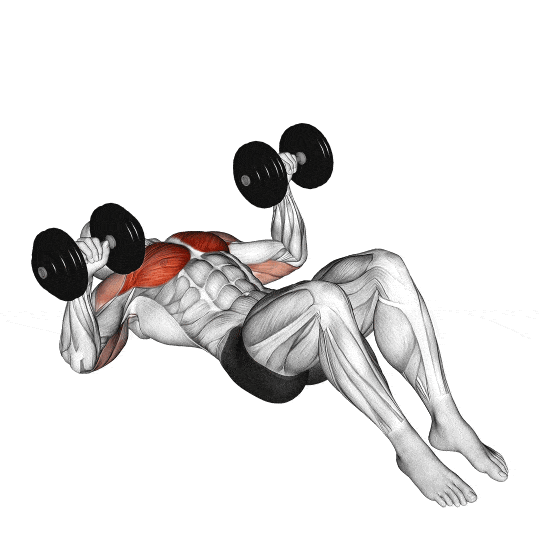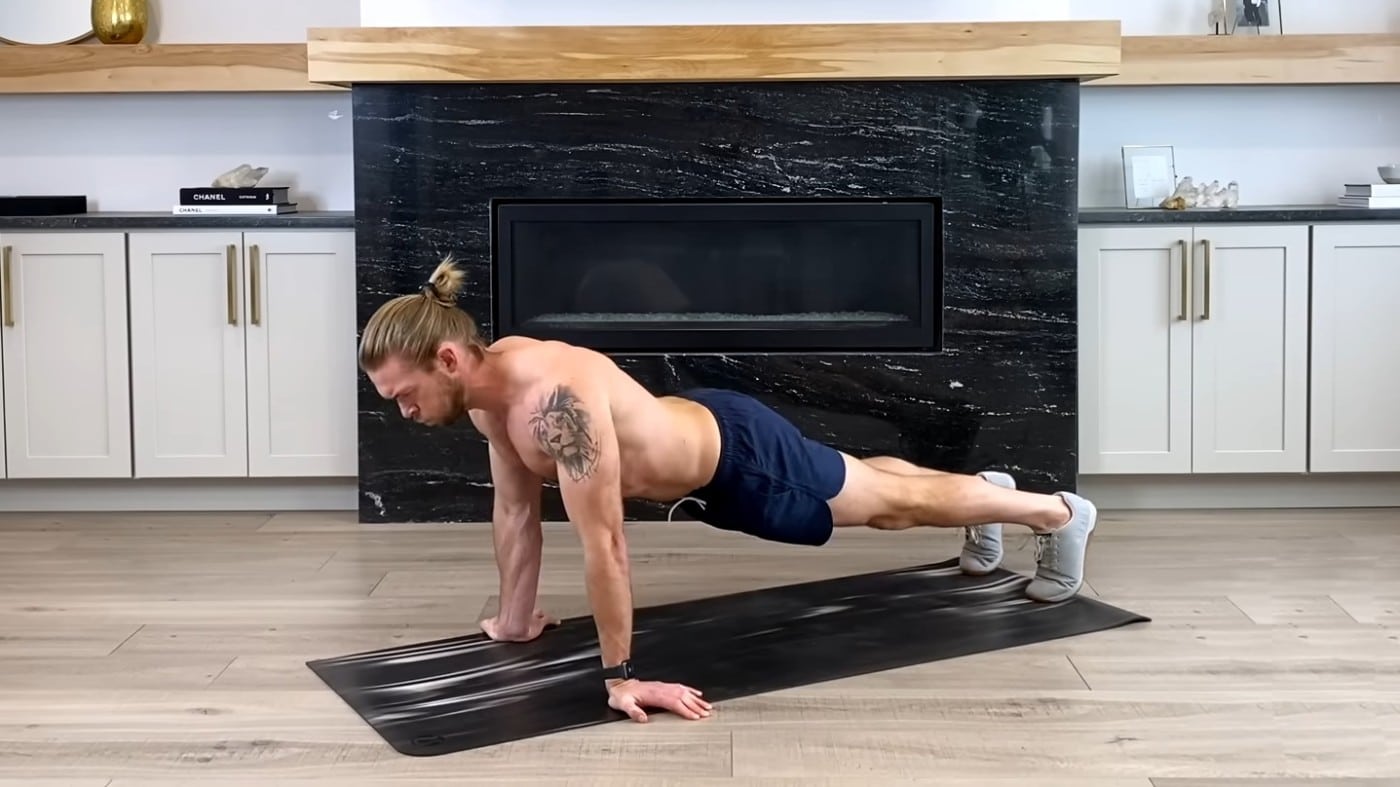Revamp your home workout routine with our comprehensive guide to home chest workouts.
Discover my warm-up routines, advanced push-up variations, bench press techniques, dips, and innovative bodyweight chest exercises you can do at home, with minimal equipment.
Enhance your conditioning, recovery, and nutrition strategies to achieve a sculpted chest.
Jump to:
- Understanding Chest Anatomy and Exercise Goals
- Essential Home Workout Equipment
- Warm-Up Routines for Chest Exercises
- Mastering Push-Up Variations
- Executing the Perfect Bench Press
- Incorporating Dips for Pectoral Strength
- Targeting Upper and Lower Chest
- Advancing with Chest Fly Variations
- Innovative Bodyweight Chest Moves
- Conditioning and Recovery
- Building a Home Chest Workout Routine
Understanding Chest Anatomy and Exercise Goals
To effectively enhance your chest through home workouts, it’s essential to know the structure of the chest muscles and to establish attainable goals that align with muscle development and definition.
Defining Chest Muscles and Functions

Your chest is composed of two primary muscles: the pectoralis major and the pectoralis minor. The pectoralis major is the larger muscle, covering most of your chest’s front and is responsible for movements like pressing and lifting. Underneath lies the pectoralis minor, smaller yet crucial for functions such as scapular movement. Together, they form what you commonly refer to as your pecs.
- Pectoralis Major: Provides chest width and power.
- Functions: Horizontal adduction, shoulder flexion, and internal rotation.
- Pectoralis Minor: Assists in stabilizing the scapula.
- Functions: Scapular downward rotation, protraction, and depression.
Setting Realistic Chest Workout Goals
When setting goals for your chest workouts at home, focus on both muscle growth and muscle definition. Balance is key – aim for progressive overload to stimulate chest development and growth, while also incorporating exercises that refine definition.
- Chest Growth: Implement push-up variations and use resistance bands to challenge your pecs.
- Muscle Definition: Include higher repetition sets and isometric holds to enhance muscle tone.
By understanding your chest anatomy and setting clear, achievable workout goals, you can effectively work towards a stronger and more defined chest.
Essential Home Workout Equipment
To effectively target your chest muscles at home, selecting the right equipment is crucial. The equipment should not only enhance your workout but also align with your fitness goals and living space.
Choosing the Right Equipment for Chest Workouts
When deciding on equipment for chest workouts, consider investing in a bench press setup if you have the space. This staple gym piece allows for a variety of chest exercises including flat, incline, and decline bench presses. Additionally, dumbbells are versatile and can be used for dumbbell bench presses and flyes, offering a range of motion that is beneficial for chest development.
- Weights: Adjustable weights are economical and space-saving.
- Resistance Bands: Excellent for different levels of tension and are travel-friendly.
- Stable Bench: Essential for supporting various angles of chest exercises.
Alternatives to Traditional Workout Gear
For tighter spaces or budgets, there are creative substitutions for traditional gear:
- Bodyweight Chest Workouts: Exercises like push-ups can effectively build chest strength without any equipment.
- Household Items: Used as makeshift weights, items like water bottles or backpacks filled with books can add resistance to your workouts.
Remember, the key is consistency and using your equipment with proper form to maximize chest development.
Warm-Up Routines for Chest Exercises
Before diving into your chest workout, initiating with a warm-up routine is imperative to prime your muscles and enhance performance. A proper warm-up can significantly reduce the risk of injury and prepare you mentally for the workout ahead.
Importance of Warm-Up to Prevent Injury
Warm-up activities elevate your heart rate, increasing blood flow to your muscles, including those in your chest, arms, and shoulders. This process makes your muscles more pliable, minimizing the risk of strains or tears. When your body is warmed up, your joints also become more lubricated, which is essential to perform exercises like push-ups with a full range of motion and without undue stress.
Effective Warm-Up Exercises
- Jumping Jacks: Start with jumping jacks to get your whole body moving. Aim for 1-2 minutes or until you feel your heart rate increase and your body temperature rise.
- Push-Up: Transition to a few sets of modified or full push-ups. Begin with 5-10 push-ups to engage your chest, shoulders, and triceps. Pay attention to form to activate the correct muscles without overexertion.
Remember to keep the movements controlled and consistent, focusing on quality over quantity.
Mastering Push-Up Variations
Push-ups are a fundamental bodyweight chest exercise that can be modified in numerous ways to enhance muscle activation and strength. Perfecting your technique in the classic push-up and exploring advanced variations are pivotal for progressive muscle development.
Classic Push-Up Form and Techniques

To execute a classic push-up, you must first get into a plank position with your hands slightly wider than shoulder-width. Ensure that your body forms a straight line from your heels to your head. Lower your body until your chest nearly touches the floor, then push back up to the starting position. Remember that proper form is crucial to prevent injuries and to engage the targeted muscles effectively.
- Maintain a neutral spine by looking slightly ahead rather than straight down.
- Activate your core and glutes throughout the movement for stability.
- Ensure your elbows are at a 45-degree angle from your body to reduce shoulder strain.
Advanced Push-Up Variations for Muscle Activation

Once you have mastered the classic push-up form, challenge yourself with advanced push-up variations. These enhancements can target different muscle groups more intensely and add diversity to your home chest workout routine.
- Incline Push-Up: Place your hands on an elevated surface to decrease difficulty, focusing on the lower pectorals.
- Decline Push-Up: Elevate your feet to increase the challenge and target the upper pectorals.
- Diamond Push-Up: Bring your hands close together under your chest to form a diamond shape with your thumbs and index fingers, emphasizing the triceps and the inner chest.
- Wide Push-Up: Set your hands wider than shoulder-width to engage more of the outer chest muscles.
Incorporating these push-up variations can activate different aspects of your chest muscles and promote balanced muscle growth. Remember to listen to your body and progress at a pace that suits your fitness level.
Executing the Perfect Bench Press
To effectively enhance your chest workouts at home, mastering the bench press is key. With a focus on proper form and technique, even without a traditional bench, you can perform variations that target different areas of your pectoral muscles.
Techniques for Bench Press without a Bench

If you don’t have access to a bench, you can still perform a dumbbell bench press on the floor. This variation limits the range of motion but still effectively targets your chest muscles.
- Floor Press: Lie on your back with knees bent and feet flat. Hold dumbbells above your chest with a grip that is comfortable, then lower them towards your chest with control before pushing them back up.
- Stability Ball Press: Using a stability ball can simulate the incline and flat bench press. Focus on keeping your body stable to engage the core.
Building Strength with Bench Press Variations
Various bench press exercises can increase your chest strength even at home. Using different angles and equipment can produce significant results.
- Flat Bench Press: The standard bench press is done on a flat bench and is a compound movement that works the entire pectoral area.
- Incline Bench Press: By setting the bench to an incline, this variation targets the upper chest. Utilize a slower movement to maximize engagement.
- Decline Bench Press: Performing the bench press on a decline focuses on the lower part of your chest muscles. Ensure your feet are secured to prevent sliding.
Each variation can be executed with either a barbell or dumbbells, allowing for flexibility depending on your available equipment. It’s essential to maintain a neutral grip and to keep your wrists straight to prevent injury. Remember, the key to maximizing the effectiveness of your bench press is consistency in practice and incremental increases in weight or resistance.
Incorporating Dips for Pectoral Strength
Dips are a powerful exercise to enhance the strength of your pectoral muscles. When executed with proper form, they can significantly improve your chest strength and overall upper-body muscle development.
Proper Dip Techniques for Maximum Effectiveness
To reap the full benefits of chest dips, focus on these key form points. First, grip the bars with your hands shoulder-width apart and hoist yourself until your arms are fully extended. As you lower your body, lean slightly forward to emphasize the pectorals. Make sure your elbows point out slightly, but do not flare them excessively. The dip should be deep enough for your shoulders to drop below your elbows, but no further, to prevent shoulder strain. Then, push back up powerfully, engaging the chest muscles to return to the start position.
- Grip: Shoulder-width
- Elbows: Slight outward flare
- Depth: Shoulders below elbows
- Motion: Push up engaging chest
Modification of Dips for Home Workouts
If you lack access to dip bars at home, you can modify dips using sturdy furniture or equipment. For instance, place your hands on two parallel surfaces such as chair backs or on the edge of a stable table. Your body should still be between the supports. Keep your legs straight out, resting on the balls of your feet to balance your weight. Perform the dip with the same form as traditional chest dips.
- Parallel Surfaces: Chairs or table edge
- Leg Position: Straight out on balls of feet
- Form: Maintain proper dip technique
With these modifications, you can perform effective dips for pectoral strength right in your home setup.
Targeting Upper and Lower Chest
To effectively develop a balanced chest, you need to engage both the upper and lower chest muscles with targeted exercises, such as the incline bench press for the upper chest and the decline press for the lower chest.
Upper Chest Focused Exercises
For the upper chest, focus on exercises that target the clavicular head of your pectoral muscles. The incline bench press is key for upper chest activation. When setting up:
- Position the bench at a 15-30 degree incline.
- Grip the barbell slightly wider than shoulder-width.
- Lower the bar towards the upper chest, then press up.
Additionally, you can perform push-ups with your feet elevated to further engage the upper chest.
Lower Chest Exercises for Balanced Development
For the lower chest, exercises should focus on the downward angle of muscle fibers. The decline press is effective for lower chest development. While at home, without a decline bench, you can try:
- Decline push-ups: Place your hands on the floor and your feet on a raised surface.
- Dips: Lean forward slightly to emphasize the lower chest.
Include these exercises in your routine to achieve a balanced and well-developed chest.
Advancing with Chest Fly Variations
When looking to expand your home chest workout, incorporating variations of the chest flye can significantly enhance muscular development and strength. Mastery of technique and the introduction of resistance bands can take your flys to the next level.
Technique for Performing Flys without Equipment
To execute a proper chest flye without equipment, find a spacious area where you can lie flat on your back. Begin by engaging your core and flattening your lower back against the ground. Extend your arms out to your sides with a slight bend in your elbows, palms facing upward. Imagine you are hugging a large tree trunk, bring your hands together above your chest, squeezing your pectoral muscles. Slowly lower your arms back to the starting position, maintaining control and tension throughout the movement.
Utilizing Resistance Bands for Chest Flye
Resistance bands offer a portable and effective way to increase the intensity of your flys. Secure the band at chest height behind you, either by closing it in a door or wrapping it around a stable object. Stand with your back to the anchor point, grasping the ends of the band with both hands. Step forward to create tension in the band. With palms facing each other, stretch your arms out to your sides and then bring your hands together in front of you, engaging the chest muscles. Return to the starting position with control. Remember to keep your shoulders down and back throughout the exercise.
Innovative Bodyweight Chest Moves
When you’re aiming to strengthen and define your chest without weights, innovative bodyweight chest moves can be your go-to solution. These exercises leverage your body’s resistance and gravity to challenge and build your pectorals.
Exploring Bodyweight Moves Beyond Push-Ups
Push-ups are the cornerstone of any bodyweight chest workout, but there’s an array of moves that can target your chest muscles from different angles and offer varying levels of difficulty. Archer push-ups, for instance, intensify the work on each side of your chest by extending one arm out to the side as you lower your body, emulating the drawing of a bow. Another less conventional move is the chest squeeze push-up, which involves pressing the palms together in front of the chest throughout the movement to deeply engage the pectoral muscles. You can also enhance your core strength while working your chest by including exercises like the bodyweight chest fly on the floor, where you mimic the fly motion against the friction of the floor.
Combining Bodyweight Exercises for Supersets
Supersets amplify the intensity of your workout by combining two exercises back-to-back with no rest. An effective chest superset can pair a pushing exercise, like decline push-ups to target the upper chest, immediately followed by dips to exhaust the lower chest and triceps. Not only do supersets increase muscular endurance, but they also save time and maintain high energy expenditure. To integrate core strengthening into your superset, alternate push-ups with plank transitions, where you switch between forearm and straight-arm planks. This combination not only works your chest but engages your entire core, fortifying your body’s central support system.
Conditioning and Recovery
Optimal conditioning and recovery are paramount to improve your chest workouts and facilitate muscle growth. Paying attention to post-workout stretching and proper nutrition can enhance recovery and prevent injury.
Post-Workout Stretching for Chest Muscles
After a chest workout, stretching is crucial for maintaining flexibility and reducing muscle tightness. Here are key stretches to incorporate:
- Doorway Stretch: Stand in a doorway with your arm bent at a 90-degree angle and push gently forward to feel the stretch in your pectoral muscles.
- Floor Chest Stretch: Lie face-down on the floor with your arms out to the side to form a T-shape and gently press your chest towards the floor.
These stretches should be held for 15-30 seconds to allow your muscles to relax properly. Proper stretching can help improve your posture over time, which in turn can help prevent injuries and imbalances.
Chest Recovery and Nutrition Tips
Your nutrition significantly impacts your recovery and conditioning progress. Here are some recovery and nutrition tips to guide you:
- Protein Intake: Aim for a diet rich in proteins such as chicken breast, tofu, and legumes to support muscle repair.
- Carbohydrates: Include complex carbohydrates like whole grains and vegetables that provide the energy needed for your workouts and recovery.
- Hydration: Stay hydrated with water or electrolyte-rich fluids to help transport nutrients to your muscles.
Remember, recovery is just as important as the workout itself. Nutritional support and adequate rest is essential for muscle strength and conditioning gains.
Building a Home Chest Workout Routine
Creating an effective home chest workout routine involves planning exercises that target all areas of the chest and scheduling appropriate rest days to maximize muscle growth and recovery. Here’s how you can structure your at-home chest training regimen.
Sample Workout Plans for Different Fitness Levels
Beginner:
- Push-Ups: 3 sets of 8-12 reps
- Incline Push-Ups: 3 sets of 8-12 reps
- Chest Dips (using chairs): 2 sets of 6-10 reps
- Diamond Push-Ups: 2 sets of 6-10 reps
Intermediate:
- Decline Push-Ups: 3 sets of 10-15 reps
- Plyometric Push-Ups: 3 sets of 8-10 reps
- Wide-Grip Push-Ups: 3 sets of 10-15 reps
- Chest Fly (with resistance bands): 3 sets of 12-15 reps
Advanced:
- One-Arm Push-Up: 3 sets of 5-8 reps (each arm)
- Archer Push-Ups: 3 sets of 8-10 reps (each side)
- Chest Press (with heavy resistance bands or dumbbells): 4 sets of 8-12 reps
- Weighted Chest Dips: 3 sets of 10-12 reps
*Note: Adjust the number of sets and reps based on your comfort and strength levels. If an exercise is too challenging to perform with correct form, reduce the intensity or regress the exercise.
Balancing Workouts with Rest Days
To ensure your muscles have time to recover and strengthen, it’s crucial to balance your chest workouts with rest days. Here’s a suggested schedule you may follow:
- Monday: Chest Day (Workout)
- Tuesday: Rest or Light Activity (e.g., walking)
- Wednesday: Upper Body Workout (focus on other muscle groups)
- Thursday: Rest or Active Recovery (e.g., yoga, stretching)
- Friday: Chest Day (Workout)
- Saturday: Rest or Light Activity
- Sunday: Active Rest (light cardio or full-body mobility work)
*Remember: Effective rest is as important as the workouts themselves. Adjust your rest days according to your body’s recovery needs and avoid training the same muscle group on consecutive days.














